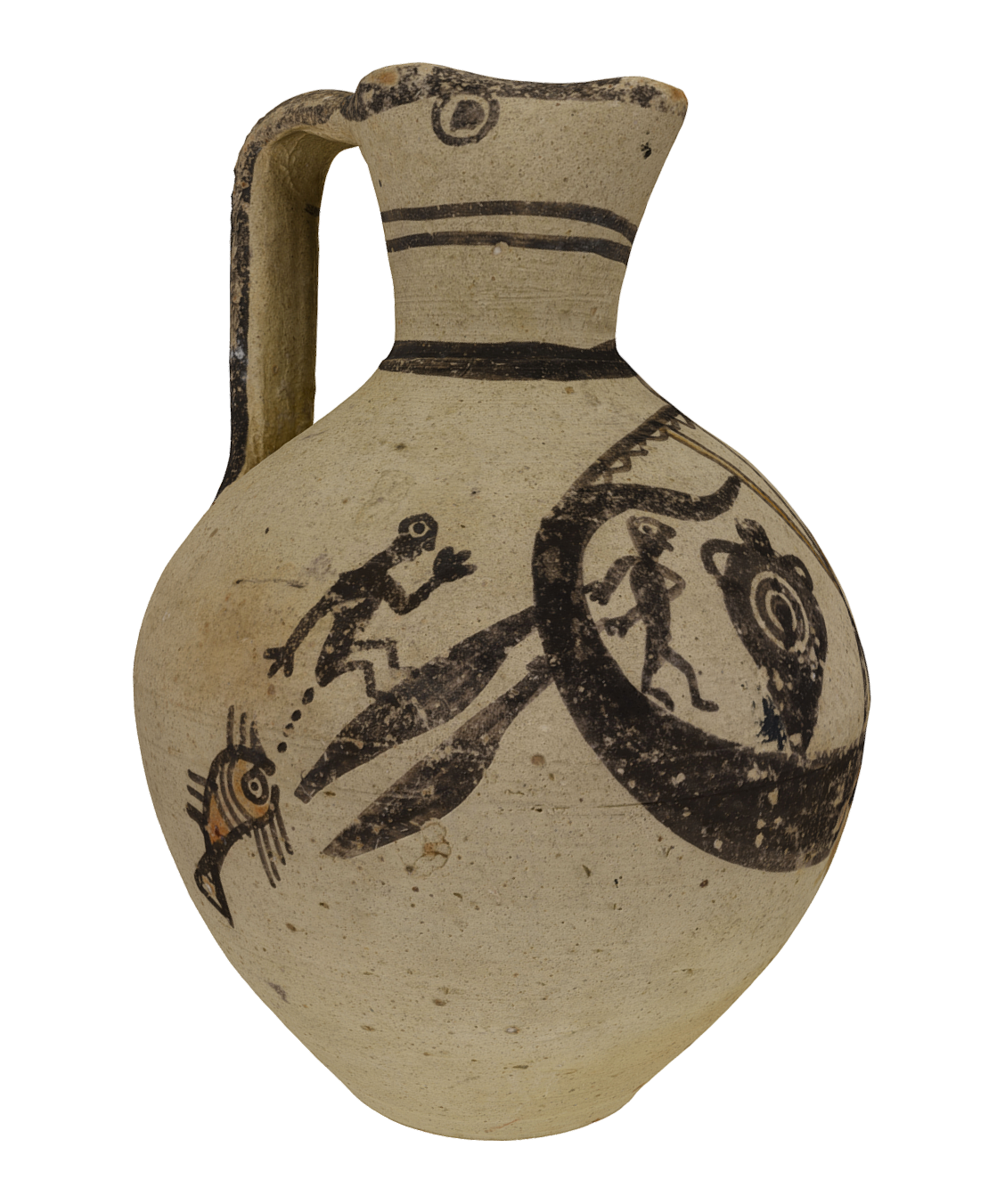Round hulled merchant ship to the right. The hull is a single thick continuous band, with a high stem and stern. Vertical stempost ending in a horn device that curves backwards then upwards, with six small projections on the inner side. The forecastle is a square with a checkerboard pattern. The sternpost ends in a horn that curves parallel to the hull. The mast is amidships, with a circular mast-head similar to the ones depicted on some of the LH IIIC vessels (Skyros, Kynos, Tragana) and indicating a loose-footed brailed sail. The yard is rendered as a slightly downwards curving line raised to the top of the mast, below which hang semicircles to denote a furled up sail. Two halyards are attached to the mast roughly midway, while two shorter oblique lines run from the hull to converge on the mast at the same point. The latter must be part of the mast-step system which secured the mast in place.
Merchant ship
C4
c. 750-600 B.C. (Cypro-Archaic I)
Karpas Peninsula (north-eastern Cyprus), probably from a tomb
H: 15.9 cm
Bichrome IV jug. Ovoid-biconical body, flat base, narrow neck splaying upward, trefoil mouth. Single strap handle from shoulder to rim. Fine buff clay, cream-buff colour, brown and orange matt paint.
Barnett 1958: 227-28; Basch 1987: 258-59, nos. 564-566; Casson 1971: 66-68; 1994: 41-44; Frost 1982: 162, fig. 1.1; Karageorghis and Des Gagniers 1974: 38, no. XI.1; Kiely 2014: 197, no. 83; Wachsmann 1998: 183-84, fig. 8.41c, 257-58, fig. 12.4; Westerberg 1983: 43-44, no. 53, fig. 53
Figural scene in the free-field style depicting a merchant ship with two large amphorae on each side of the mast. At the bow, a sailor standing on the horn device of the stempost operates a one-holed stone anchor. At the stern, a helmsman on a smaller scale handles the two steering oars. A third sailor behind the stern squats on top of the upper steering oar, as he defecates directly into the open mouth of a large fish. A matt red colour is used for the body of the fish and the rigging elements (braces). The furled sail and the maneuvering of the anchor suggests that the ship is reaching safe mooring.
The hull is not nearly as rockered as suggested by the drawing in Karageorghis and Des Gagniers which has been taken up by Basch and Wachsmann. My drawing rectifies this, showing that the hull is in fact quite straight.1 The stempost device has been interpreted by Wachsmann as an abstract bird head, a suggestion which finds support in the other two contemporaneous Cypriot ship depictions which have much more naturalistic looking bird-head devices that are similarly oriented inboard. The oblique lines which secure the mast in place are also a recurrent feature of these Cypriot depictions, although on the other two the device is simply portrayed as a triangular block of paint at the base of the mast.
The artist was obviously not overly concerned with realism considering the placement of the squatting figure and the sailor operating the stone anchor. Size was also adapted liberally, with the helmsman painted on a smaller scale to fit the composition, while the two amphorae are enormous. This is a rare illustration showing the raising/lowering of the anchor. Frost has argued for the use of booms or derrick-arms attached to the mast for maneuvering the anchors (Frost 1989; 1995). It is possible that for the sake of composition, the artist chose to displace the system to the right, further along the yard rather than through the sheave of the masthead as depicted on the Nicosia ship. The upward angle of the line and the position of the sailor's hand does favor a derrick interpretation, which would be needed in light of the weight of the anchor.
The shape of the amphorae does not equate closely to any known eastern Mediterranean transport jars of the period. Kiely argues that they probably combine the top-heavy body and pointed base of Cypriot basket-handle jars with the protruding ear handles of Levantine jars (including the very popular "Canaanite jars" of the LBA-EIA period). Likewise, their decoration consisting of groups of concentric circles likely reflects the prevalence of this motif in EIA painted pottery (Schreiber 2003: 74-75). The round single-holed anchor depicted is of a widespread type used on Cyprus and the Levant throughout the LBA and EIA periods.
1. Incidentally, a more accurate rendition can be seen by the Nautical Archaeology Society which uses the depiction as its icon.
Barnett, R. D. 1958. “Early Shipping in the Near East,” Antiquity 32: 220-230.
Basch, L. 1987. Le musée imaginaire de la marine antique. Athens: Institut Hellénique pour la preservation de la tradition nautique.
Casson, L. 1971. Ships and Seamanship in the Ancient World. Princeton: Princeton University Press.
―――. 1994. Ships and Seafaring in Ancient Times. London: British Museum Press.
Frost, H. 1982. “On a sacred Cypriote Anchor,” in J. Starcky and F. Hours (eds.) Archéologie au Levant: recueil à la mémoire de Roger Saidah. Lyon: Maison de l'Orient, pp. 161-66.
Karageorghis, V. and J. Des Gagniers. 1974. La céramique chypriote de style figuré. Âge du Fer (1050-500 av. J.-C.). Roma: Istituto per gli Studi Micenei ed Egeo-Anatolici.
Kiely, T. 2014. “Jug with Image of a Cargo Ship.” in J. Aruz, S.B. Graff and Y. Rakic (eds.) Assyria to Iberia at the Dawn of the Classical Age. New York: The Metropolitan Museum of Art, pp. 197.
Wachsmann, S. 1998. Seagoing Ships & Seamanship in the Bronze Age Levant. College Station, TX: Texas A&M University Press.
Westerberg, K. 1983. Cypriote Ships from the Bronze Age to c. 500 B.C. (SIMA, Pocket-books, 22). Göteborg: P. Åströms förlag.









